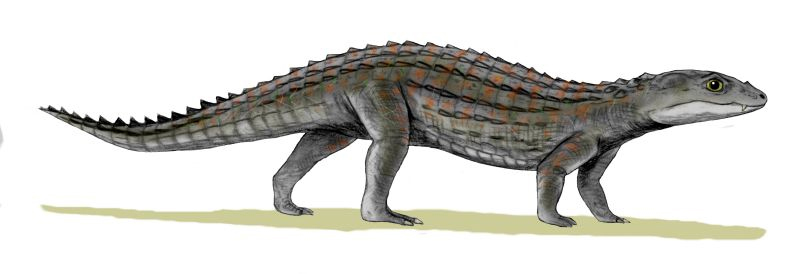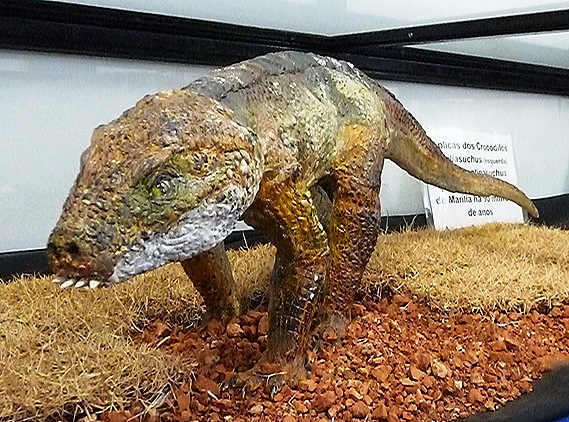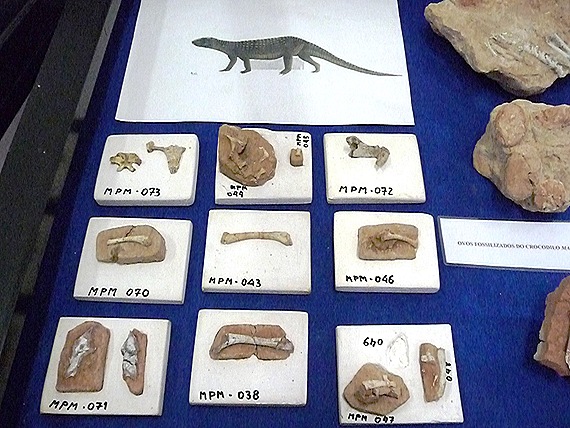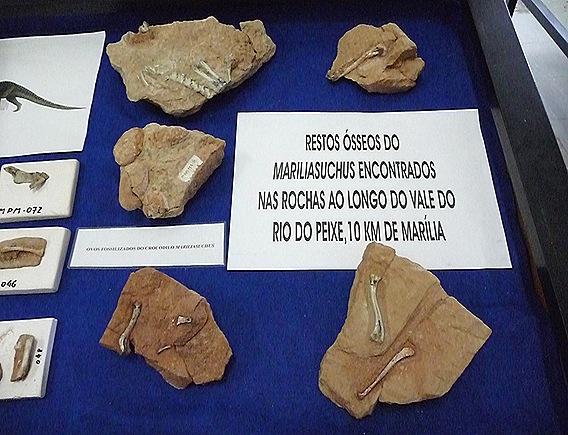[Recent Entries][Archive][Friends][User Info]
March 23rd, 2014
| March 23rd, 2014 | |
|---|---|
| 06:28 pm [industrialterro] [Link] |
Comahuesuchus Comahuesuchus is an extinct genus of notosuchian crocodylomorph from the Late Cretaceous of Argentina. It was described by palaeontologist José Bonaparte in 1991. The type species is C. brachybuccalis. The holotype of C. brachybuccalis is MUCPv-202. Comahuesuchus is the name-sake of the clade Comahuesuchidae. Sereno et al. (2003) suggested that Comahuesuchus and Anatosuchus are both comahuesuchids, but work by Martinelli and Andrade et al. (2006), has suggested that A. minor is not a comahuesuchid. Comahuesuchus seems instead to be more closely related to Mariliasuchus. Tags: Вымершие рептилии, Мел, архозавроморфы, архозавры, диапсиды, крокодиломорфы, круротарзы, мезоэукрокодилии, нотозухии, равизухии |
| Time | Event |
| 06:48 pm [industrialterro] [Link] |
Mariliasuchus Mariliasuchus ("Marilia crocodile") is an extinct genus of Late Cretaceous notosuchian mesoeucrocodylian found near Marilia, Brazil. The first bone remains were found and collected in 1995 by Brazilian paleontologist William Nava, in red rocks from Adamantina Formation. Four years later, it was described as "Mariliasuchus amarali", by Brazilian palaeontologists Ismar de Souza Carvalho and Reinaldo J. Bertini. Its type species M. amarali, in honour of Sérgio Estanislaw do Amaral, Brazilian naturalist. A second species, M. robustus, was named in 2007. Several specimens of M. amarali have been found close to eggs, eggshells and coprólites to date:
Abbreviations: All of these specimens have been recovered in a road cut, 10 km south from the city of Marilia, in outcrops known as "Estrada Velha" pto. 1 and 2. They come from the upper part of the Adamantina Formation, indicating a Late Cretaceous (possibly Campanian/Maastrichtian) age. A phylogenetic analysis done by Zaher et al. (2006) found Mariliasuchus amarali to share a close relationship with Comahuesuchus. Andrade et al. (2006), while studying the palate and choanae of some mesoeucrocodylians, reached this same conclusion. Though no name was given to this clade in either publication, it is referred in this article as Comahuesuchidae. Mariliasuchus, unlike modern crocodylians, was an animal of terrestrial habits (though see below). Its nostrils were located on the front of the skull, unlike modern crocodiles, in which the nostrils face upwards, to help the animal breathe while its almost completely submerged. Furthermore, the eyes in M. amarali are faced laterally (in modern crocodiles they face upwards). It had a very modified dentition, differentiated in incisiforms, caniforms and molariforms. Strangelly, in particular, were the anterior-most teeth, which were directed horizontally rather than vertically. The function of this strange arrangement is not yet clear, but Vasconcellos et al. (2002) made comparisons with the dentition of pigs, indicating that their dietary preferences may be convergent. It also had strong jaw muscles, indicating a good degree of mandibular activity. There seems to be a significant degree of variation between specimens of M. amarali. Some of this is related to ontogenetic variation, but some may also suggest sexual dimorphism, or even that some of the specimens assigned to this species belong to a different animal. Ontogenetic studies done by Vasconcellos and Carvalho (2005) concluded that during its growth, the skull of M. amarali individuals becomes shorter and the skull more resistant, while being laterally compressed. In adulthood, the orbit has a less circular arrangement than in younger individuals. The postcranial skeleton of Mariliasuchus amarali displays a mixture of traits similar to those present in the skeleton of Cretaceous terrestrial crocodyliform Notosuchus and traits present in aquatic eusuchian crocodyliform, including living crocodilians. Nobre and Carvalho (2013) inferred that Mariliasuchus did not have an erect or semi-erect posture, but rather a sprawling posture and, possibly, had amphibian habits similar to those of living crocodilians. Notosuchidae is a Gondwanan family of notosuchians. They were small-bodied terrestrial crocodyliforms that lived during the Late Cretaceous. Ископаемые останки (1, 2, 3, 4): Tags: Вымершие рептилии, Мел, архозавроморфы, архозавры, диапсиды, крокодиломорфы, круротарзы, мезоэукрокодилии, нотозухиды, нотозухии, равизухии |
| Time | Event |
| 07:53 pm [industrialterro] [Link] |
Morrinhosuchus Morrinhosuchus is an extinct genus of notosuchian crocodyliform from the Late Cretaceous Adamantina Formation of Brazil. It is known from a mandible and a portion of the front of the skull collected from the municipality of Monte Alto in São Paulo state. Morrinhosuchus refers to Morrinho de Santa Luzia, a hill nearby the collection site of the holotype, while luziae refers to the chapel of Santa Luzia, which is located on top of the hill. The skull and jaws are posteriorly broad but narrow significantly toward the front. The teeth at the back of the jaw are bulbous in shape and circular in cross-section (this shape is only found in one other notosuchian, Mariliasuchus, also from the Adamantina Formation). The mandible arches upward. The symphysis, or area where the two sides of the lower jaw meet, is formed mostly by the mandibles but also partly by the splenials. The skull preserves an antorbital fenestra, or opening in front of the eyes. The nasal, a bone at the top of the skull behind the nostrils, is relatively long. There is also a small notch at the contact between the premaxilla and the maxilla near the front of the snout. Morrinhosuchus can be distinguished from Mariliasuchus on the basis of several unique features. For example, there is a gap between the maxilla and the palatine bone around the midline of the palate. The palate itself is also wider than that of Mariliasuchus. While the teeth of the two genera are very similar, their number and placement in the jaw differs slightly. Morrinhosuchus has seven post-caniniform teeth while Mariliasuchus has only six. There are also differences in the shape of the rostrum between the two genera, as Morrinhosuchus has a higher, more pointed snout with less constriction than in Mariliasuchus. The Adamantina Formation, which is Turonian to Santonian in age, was deposited in semi-arid conditions around 95 million years ago. Morrinhosuchus was found in an outcrop of reddish sandstone with carbonate nodules, concretions, and areas of intense bioturbation. The Adamantina Formation is part of the larger Bauru Basin, from which several other notosuchians have been found. These include Sphagesaurus, Mariliasuchus, Adamantinasuchus, Armadillosuchus, and Baurusuchus. Tags: Вымершие рептилии, Мел, архозавроморфы, архозавры, диапсиды, зифозухии, крокодиломорфы, круротарзы, мезоэукрокодилии, нотозухии, равизухии |
| Previous Day | 2014/03/23 [Archive] |
Next Day |








